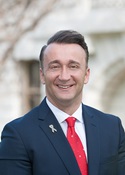Aston
Margin: Liberal 8.2%
Region: Eastern Melbourne, Victoria
In a nutshell: Scene of a morale-boosting victory for the Howard government in 2001, Aston has become an increasingly difficult proposition for Labor over the decades, having stayed beyond their grasp since 1990.
Candidates in ballot paper order

|
STEVE RAYMOND DANIEL EDWARD MARTIN DANIEL HUPPERT JOEL MOORE ROSEMARY LAVIN ALAN TUDGE PAUL KLISARIS |
The outer eastern Melbourne electorate of Aston was created with the expansion of parliament in 1984, from territory that had mostly been accommodated by La Trobe since its creation in 1949. It covers the Liberal-leaning suburbs of Wantirna in the north and Rowville in the south, along with naturally marginal territory in Wantirna’s eastern neigbours Bayswater and Ferntree Gully. Labor held the seat for the first two terms of its existence, but it steadily strengthened for the Liberals over time, and is currently held on a margin of 8.2%.
The seat’s inaugural member was John Saunderson, who had gained Deakin for Labor when the Hawke government came to power in 1983. Saunderson inherited a notional Labor margin of 7.0% which fell to 3.6% at the 1987 election, before copping the full force of the statewide battering that cost Labor nine Victorian seats in 1990, the swing in this case being 10.1%. The incoming Liberal member was Peter Nugent, a moderate noted for bucking his party’s line on indigenous issues. The by-election held three months after Nugent’s sudden death in April 2001 delivered the Howard government a morale-boosting win that predated the game-changing Tampa episode by a month, with a 3.7% swing to Labor falling short of the 4.2% Liberal margin.
The member for the next two terms was Chris Pearce, a Knox councillor and managing director of an information technology company. Pearce picked up a 7.1% swing at the 2004 election, the biggest in the state in the context of a strong performance by the Liberals throughout suburban Melbourne. It was widely noted that this left the seat with a bigger Liberal margin than the famously blue-ribbon Kooyong, which was seen to typify the hold the Howard government had secured in middle-income outer suburbs. However, it equally joined many such seats in swinging heavily to Labor in 2007, when an 8.1% swing reduced Pearce’s margin to 5.1%.
With Pearce bowing out at the 2010 election, a hotly contested Liberal preselection was won by Alan Tudge, a former staffer to Brendan Nelson and Alexander Downer, ahead of Neil Angus, a chartered accountant who would go on to win Forest Hill for the Liberals at the 2010 state election. Labor was vaguely hopeful that Pearce’s retirement would help add Aston to a list of Victorian gains that would compensate for expected losses in New South Wales and Queensland, but the 3.3% swing left Tudge with a margin of 1.8%. The subsequent redistribution cut the margin further back to 0.7%, by adding Boronia and removing Vermont, but the tide at the 2013 election flowed heavily the other way, blowing the margin out to 8.2%.
Tudge won promotion after the election to parliamentary secretary to the Prime Minister, and retained that ranking with a further gain of the social services portfolio when Malcolm Turnbull took over the leadership in September 2015, despite having supported Tony Abbott. A more substantial promotion followed in February, when he assumed the outer ministry portfolio of human services after the resignation of Stuart Robert.
Analysis by William Bowe. Read William’s blog, The Poll Bludger.


